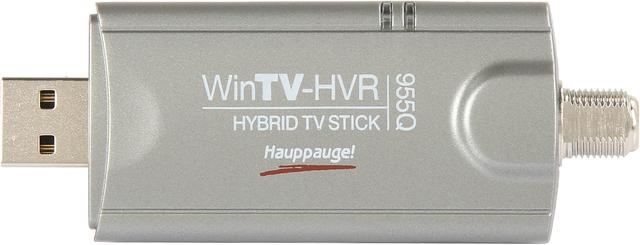

- #Hauppauge wintv hvr 950q how to
- #Hauppauge wintv hvr 950q install
- #Hauppauge wintv hvr 950q drivers
- #Hauppauge wintv hvr 950q update
- #Hauppauge wintv hvr 950q Patch
I haven't figured out how to get tvtime to get connected to that driver.
#Hauppauge wintv hvr 950q drivers
I eventually enable a whole bunch of DVB USB video and audio drivers to get tvtime to recognize the device, but it eventually did and tvtime runs but still doesn't have any sound.ĭmesg shows the 950Q's sound driver to be snd-usb-audio. The linuxtv website says that the driver is xc5000. I was able to get it to be recognized in tvtime. I have the same Hauppauge WinTV-HVR-950Q interface. I see with dmesg that the firmware is loaded.

Yes, I compiled all the modules possible and even downloaded the firmware (for my kernel) and put it in /lib/firmware.
#Hauppauge wintv hvr 950q install
I ran tvtime-scan and found 6 channels, but when I try to go to any channel, all I get is no signal.ĭid you install the firmware as well as compile all the kernel modules? I thought I got the HVR-950Q working, but when I start tvtime, all I get is no signal. Posted: Sat 6:30 am Post subject: Hauppauge HVR-950Q Technically you could try to add the source in yourself and build the module, but if the source is missing, then there might be a reason for it.Gentoo Forums :: View topic - Hauppauge HVR-950Q It is unlikely NVIDIA removed it, and I suspect someone knowing more about the driver would have to answer that question (NVIDIA would not be able to answer why someone else removed the source from that release version). So this driver may have been excluded from this release, but I don’t know why. You can check your kernel version with “ uname -r”. Looking at this URL it claims the driver should be available in the current kernel. The part which looks odd is that this symbol does not occur, at all, in any form. The normal scenario is that if you have that hardware you’d add the driver. You could search for the symbol CONFIG_MEDIA_TUNER_XC5000 (I cheated and looked up the hardware), and I would expect this to not normally be compiled since few people will use this. If the feature is not listed at all, and I mean not even listed as not built, then probably the source code was not present in this kernel and there would be no possibility of building this without outside source code. If the line starts as a comment with the “hash” mark ‘ #’, then the feature could have been set, but was not built. If you see “ =m”, then the feature was compiled as a module and the module file would be somewhere within “ /lib/modules/$(uname -r)/kernel/”. If you see “ =y”, then that feature was compiled in integrated into the kernel Image. If you run this command, it will show all symbols (and symbols are how you find drivers): The file “ /proc/config.gz” is not a real file, this is the kernel showing its configuration in the running system. Just some information to add, not an answer. Linux jetson-desktop 4.9.140 #1 SMP PREEMPT Thu Jul 30 10:12: aarch64 aarch64 aarch64 GNU/Linux
#Hauppauge wintv hvr 950q update
# update bootloader in /boot/extlinux/nfĪPPEND $ quiet root=/dev/mmcblk0p1 rw rootwait rootfstype=ext4 console=ttyS0,115200n8 console=tty0 fbcon=map:0 net.ifnames=0 Lrwxrwxrwx 1 root root 60 Jul 30 10:35 source -> /home/jetson/Linux_for_Tegra/source/public/kernel/kernel-4.9

rw-r-r- 1 root root 85 Jul 30 10:35 modules.softdep
#Hauppauge wintv hvr 950q Patch
# download patch suggested in "" -O "rndis_host-support-Novatel-Verizon-USB730L.patch"ĭrwxr-xr-x 8 root root 4096 Jul 30 10:35 kernel Linux jetson-desktop 4.9.140-tegra #1 SMP PREEMPT Thu Jun 25 21:25: aarch64 aarch64 aarch64 GNU/Linux I believe everything is built properly but ATSC dongle is still behaving the same. # black screen after startup processes complete Sudo cp -rp ~/kernel/arch/arm64/boot/dts /boot Sudo cp ~/kernel/arch/arm64/boot/Image /boot/Image Make ARCH=arm64 O=$TEGRA_KERNEL_OUT -j$(nproc) Make ARCH=arm64 O=$TEGRA_KERNEL_OUT tegra_defconfig # manually copy patch to new patch suggested in usb.patch The following are the steps I took to get there. That being said, I tried my best to make sense of it and now I’m left with an OS that gets through the startup processes and then turns into a black screen instead of a login screen. Following the guide at, there is much to be left to interpretation.


 0 kommentar(er)
0 kommentar(er)
